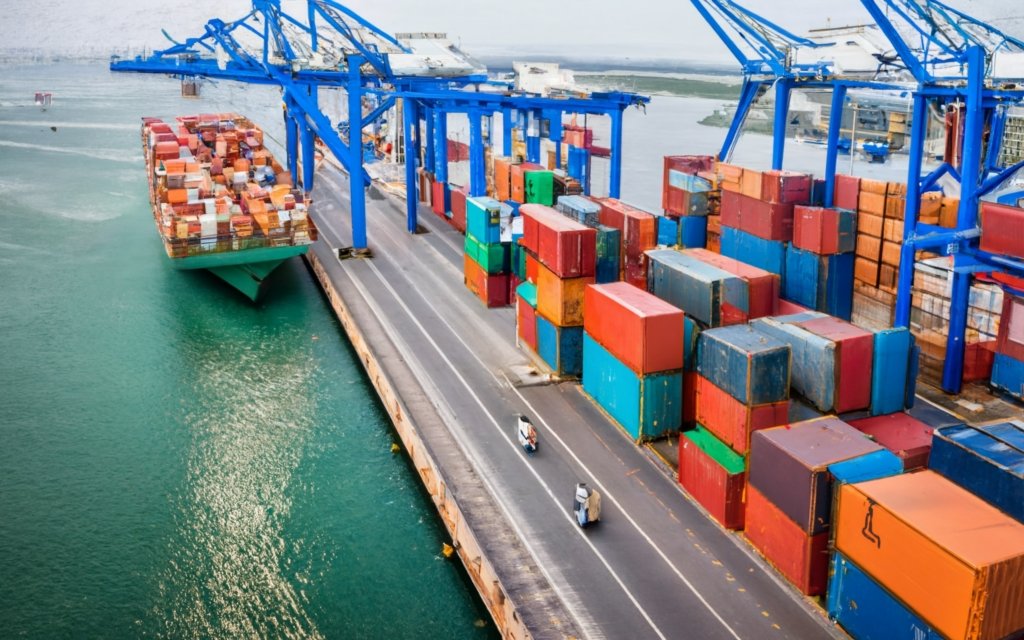Shipping containers are essential for transporting goods across the world. They are standardized, durable, and versatile, making them ideal for various types of cargo. However, not all shipping containers are the same size. The width of a shipping container can have a significant impact on the logistics efficiency, cost, and performance of your business. In this article, we will explore the role of shipping containers in logistics, the common container widths and their pros and cons, the factors to consider when choosing the right container width, and some tips and trends for optimizing your container width.
shipping containers width
Understanding the role of shipping containers in logistics

Shipping containers are rectangular metal boxes that are designed to be stacked, loaded, and transported by ships, trucks, trains, or planes. They are also known as intermodal containers, meaning they can be moved from one mode of transport to another without unloading or reloading the cargo. This reduces the handling time, damage risk, and theft risk of the goods.
Shipping containers are held to very specific dimensional standards to ensure they can be safely stacked on top of, and below, any other shipping container in the world. The International Organization for Standardization (ISO) sets the standard for shipping container dimensions. General-purpose containers are 8 feet (2.44m) wide and 8.5 feet (2.59m) high. They come in two lengths; 20 feet (6.06m) and 40 feet (12.2m). A 40-foot high-cube shipping container or extra tall shipping containers are available at 9.5 feet (2.89m) high. There are also other types of containers, such as reefer containers, tank containers, open-top containers, flat-rack containers, etc., that have different dimensions and specifications depending on their purpose.
The width of a shipping container is important because it determines how much cargo can fit inside it and how much space it occupies on the transport vehicle or vessel. The wider the container, the more cargo volume and weight it can hold, but also the more space it takes up and the more fuel it consumes. Therefore, choosing the right container width is a trade-off between maximizing capacity and minimizing cost.
The impact of container width on logistics efficiency
The width of a shipping container affects several aspects of logistics efficiency, such as:
- Loading and unloading time: The wider the container, the more time it takes to load and unload it with cargo. This can affect the turnaround time and productivity of the transport operations.
- Cargo compatibility: The width of a container should match the size and shape of the cargo that is being shipped. If the container is too wide or too narrow for the cargo, it can result in wasted space or damage to the goods.
- Transportation mode: The width of a container can limit or expand the transportation options available for moving it from one place to another. Some modes of transport have restrictions on the maximum width of a container that they can accommodate. For example, most railroads in North America can only handle containers up to 8 feet 6 inches (2.59m) wide. On the other hand, some modes of transport can offer advantages for wider containers. For example, some ships can carry more containers per slot if they are wider than 8 feet.
- Cost: The width of a container can affect the cost of shipping in various ways. For example, wider containers can reduce the number of containers needed to ship a given amount of cargo, which can lower the container rental or purchase cost. However, wider containers can also increase the fuel consumption and emissions of the transport vehicle or vessel, which can raise the transportation cost and environmental impact.
Common container widths and their pros and cons

The most common container widths are 8 feet (2.44m), 8 feet 6 inches (2.59m), and 9 feet 6 inches (2.89m). Each of these widths has its own advantages and disadvantages depending on the type and quantity of cargo being shipped.
8 feet (2.44m) wide containers
These are the standard ISO containers that are widely used for general-purpose cargo. They have a capacity of about 33 cubic meters (1,172 cubic feet) for a 20-foot container and about 67 cubic meters (2,377 cubic feet) for a 40-foot container. They are compatible with most modes of transport and have lower fuel consumption than wider containers.
However, these containers may not be suitable for some types of cargo that require more space or ventilation. For example, bulky or irregularly shaped items may not fit well in these containers or may leave a lot of unused space. Similarly, perishable or temperature-sensitive goods may need more air circulation or insulation than these containers can provide.
8 feet 6 inches (2.59m) wide containers
These are slightly wider than the standard ISO containers and are also known as high-cube containers. They have a capacity of about 37 cubic meters (1,300 cubic feet) for a 20-foot container and about 76 cubic meters (2,694 cubic feet) for a 40-foot container. They can accommodate more cargo volume and weight than the standard containers and are ideal for goods that need more height or width.
However, these containers may not be compatible with some modes of transport, especially railroads. They may also have higher fuel consumption and emissions than the standard containers and may incur additional fees or surcharges for their extra size.
9 feet 6 inches (2.89m) wide containers
These are the widest containers available and are also known as extra-wide or super-wide containers. They have a capacity of about 42 cubic meters (1,485 cubic feet) for a 20-foot container and about 86 cubic meters (3,040 cubic feet) for a 40-foot container. They can hold the most cargo volume and weight among the common container widths and are suitable for goods that need even more space or ventilation.
However, these containers are very limited in their transportation options, as they can only be moved by ships or trucks that can handle their extra width. They also have the highest fuel consumption and emissions among the common container widths and may face significant fees or surcharges for their extra size.
Factors to consider when choosing the right container width

Choosing the right container width for your logistics needs depends on several factors, such as:
- The type and quantity of cargo: The first and foremost factor to consider is the nature and amount of goods that you want to ship. You should choose a container width that matches the size and shape of your cargo, and that can hold the desired quantity of goods without wasting space or exceeding the weight limit.
- The transportation mode: The second factor to consider is the mode of transport that you want to use to move your container from one place to another. You should choose a container width that is compatible with the transport vehicle or vessel that you plan to use, and that can offer the best efficiency and cost-effectiveness for your shipping route.
- The cost and availability: The third factor to consider is the cost and availability of the container width that you want to use. You should compare the prices and availability of different container widths from various suppliers, and choose the one that offers the best value for your budget and timeline.
- The regulations and standards: The fourth factor to consider is the regulations and standards that apply to your shipping destination and origin. You should check the local laws and customs requirements that may affect your container width choice, such as maximum dimensions, weight limits, fees, taxes, inspections, etc.
Streamlining operations with the optimal container width
Choosing the optimal container width for your logistics needs can help you streamline your operations and improve your performance. Some of the benefits of using the right container width are:
shipping containers width
- Reducing shipping costs: By using a container width that matches your cargo size and quantity, you can reduce the number of containers needed to ship your goods, which can lower your container rental or purchase cost. You can also reduce the fuel consumption and emissions of your transport vehicle or vessel, which can lower your transportation cost and environmental impact.
- Increasing shipping efficiency: By using a container width that is compatible with your transportation mode, you can increase the loading and unloading time of your container, which can increase your turnaround time and productivity. You can also increase the cargo compatibility of your container, which can reduce the risk of damage or theft of your goods.
- Enhancing customer satisfaction: By using a container width that meets the regulations and standards of your shipping destination and origin, you can avoid delays, fines, or penalties that may affect your delivery time and quality. You can also enhance your customer satisfaction by delivering your goods in good condition and in accordance with their expectations.
Case studies: Successful implementation of the right container width

Here are some examples of how some businesses have successfully implemented the right container width for their logistics needs:
- IKEA: The Swedish furniture giant IKEA uses 9 feet 6 inches (2.89m) wide containers to ship its flat-packed products around the world. By using these extra-wide containers, IKEA can fit more products per container, which reduces its shipping costs and carbon footprint. IKEA also uses specially designed ships that can carry more containers per slot if they are wider than 8 feet. This further increases its shipping efficiency and sustainability.
- Maersk Line: The Danish shipping company Maersk Line uses 8 feet 6 inches (2.59m) wide containers to ship its refrigerated products around the world. By using these high-cube containers, Maersk Line can offer more space and ventilation for its perishable goods, which improves its quality and shelf life. Maersk Line also uses advanced technologies such as remote container management and smart reefer solutions to monitor and control the temperature, humidity, and location of its containers.
- Amazon: The American e-commerce giant Amazon uses 8 feet (2.44m) wide containers to ship its products around the world. By using these standard ISO containers, Amazon can benefit from the compatibility and availability of these containers across various modes of transport and regions. Amazon also uses innovative methods such as container sharing and modular delivery stations to optimize its container utilization and distribution.
Tips for choosing the right container width for your specific needs.

Here are some tips to help you choose the right container width for your specific logistics needs:
- Analyze your cargo profile: The first step is to analyze your cargo profile, such as the type, size, shape, quantity, weight, and value of your goods. You should also consider the frequency, seasonality, and variability of your shipments.
- Evaluate your transportation options: The second step is to evaluate your transportation options, such as the mode, route, distance, speed, and cost of your transport. You should also consider the availability, reliability, and flexibility of your transport providers.
- Compare different container widths: The third step is to compare different container widths based on their capacity, compatibility, cost, and availability. You should also consider the regulations and standards that apply to your shipping destination and origin.
- Choose the optimal container width: The fourth step is to choose the optimal container width that offers the best balance between maximizing capacity and minimizing cost. You should also consider the impact of your container width choice on your shipping efficiency and customer satisfaction.
The future of container width in logistics
Container width is a key factor that affects the logistics performance and competitiveness of businesses. As the global trade and transportation landscape evolves, container width may also change to adapt to new challenges and opportunities. Some of the possible trends and innovations in container width optimization are:
shipping containers width
- Customized containers: As customers demand more personalized and tailored products and services, businesses may need to use customized containers that can meet their specific needs and preferences. For example, some businesses may use containers that have special features or functions, such as solar panels, smart locks, or sensors.
- Modular containers: As logistics operations become more complex and dynamic, businesses may need to use modular containers that can be easily assembled or disassembled according to their changing needs. For example, some businesses may use containers that can be split or combined into different sizes or shapes, such as cubes or triangles.
- Sustainable containers: As environmental awareness and responsibility increase, businesses may need to use sustainable containers that can reduce their environmental impact and enhance their social value. For example, some businesses may use containers that are made of recycled or biodegradable materials, or that can be reused or repurposed for other uses.
Conclusion
Shipping containers are vital for moving goods around the world. However, not all shipping containers are the same size. The width of a shipping container can have a significant impact on the logistics efficiency, cost, and performance of your business. Therefore, choosing the right container width is a crucial decision that requires careful analysis and evaluation of various factors.




